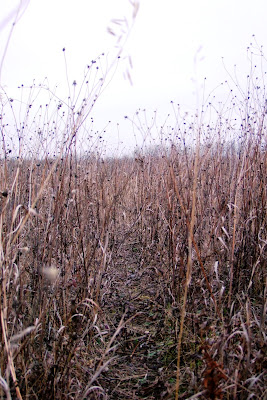 This is the Sturgeon River in early November -- at sunset, with the first ice film glazing the still water, like mica-isinglass, the brush and sedge bleached and bowing low towards the water.
This is the Sturgeon River in early November -- at sunset, with the first ice film glazing the still water, like mica-isinglass, the brush and sedge bleached and bowing low towards the water.
When I took these photos, the muskrats were still very active, swimming to and fro near the bridge...

There were only narrow, frosted edges of ice flanking the slow current, and the little muskrats would clamber gingerly out onto the platforms to nibble on shoots and riverplants before heading into the water again.

Around sundown, great numbers would gather in conferences, washing their paws and smoothing their whiskers, but never getting tooo close to one another (I did witness one muskrat-squabble, it involved snorting and splashing).
They swam like winter was approaching, busily plucking plants and traversing the channels beneath the ice sheets -- it was amazing to watch them swim beneath the translucence, the murky green water pressing up against the glass, their webbed feet pushing off the film, following the trail of water bubbles as they slipped into their bankside nests.

Muskrats don't hibernate, rather they continue to slip out from their tunnels into the flow beneath the ice to find decaying plants and small mud-buried larva; though we won't see them until the melt comes, they will follow the same water-paths under the frozen surface all winter.

Muskrats don't hibernate, rather they continue to slip out from their tunnels into the flow beneath the ice to find decaying plants and small mud-buried larva; though we won't see them until the melt comes, they will follow the same water-paths under the frozen surface all winter.
They seem more at home beneath the surface than above it -- it was the muskrat, after all, who dove down in many Algonquian and Iroquoian creation stories to fetch the earth from the bottom of the great lake in order to create the land, when all the other animals had failed.










